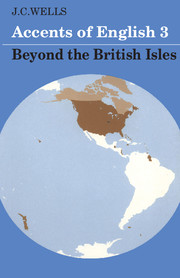8 - The southern hemisphere
Published online by Cambridge University Press: 05 June 2012
Summary
The Australian and New Zealand accents of English are very similar to one another. South African, although differing in a number of important respects, also has a general similarity to Australian. These facts are not surprising when we consider that all three territories were settled from Britain at about the same time, the English language becoming established in each around the beginning of the nineteenth century. All reflect, therefore, the developments which had taken place in the south of England up to that time: they are non-rhotic and have bath Broadening. The intervening 150–200 years have been quite long enough for them to have developed their own characteristic local accents. Notable are the loss of the weak-syllable contrast /I/ vs. /∂/, and the raising of the short front vowels of trap and dress. From the fact that these accents have little or no T Glottalling (vol. 1, 3.4.5), we can infer that at the time their accents were essentially formed this development had not yet taken place in Britain. It is appropriate to group these three regional forms under the common heading of southern-hemisphere English.
Another, very small, native-English-speaking community in the southern hemisphere is the 2000-strong population of the Falkland Isles. Interestingly enough, the brief samples of Falklands pronunciation I have heard were rather reminiscent of an Australian accent. The vowels are not of the Scottish type the settlement history would lead one to expect.
- Type
- Chapter
- Information
- Accents of EnglishBeyond the British Isles, pp. 592 - 622Publisher: Cambridge University PressPrint publication year: 1982



